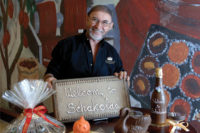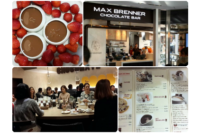When Jean-Pierre Wybauw walked in the French Pastry School’s conference room and sat down for an early afternoon interview, one couldn’t tell that the Belgian-born, world-class chocolatier had begun his day at 4:30 in the morning. But then, that’s the typical wakeup call for instructors teaching classes from 6 a.m to 1 p.m. at the Chicago-based culinary school.
In Wybauw’s case, the three-day course on Fine Chocolate Candies and Belgium Classics featured an intense program focused on tempering, cooling, shelf-life extension and general problem solving. Students – 16 in all – create moulded, dipped, piped and cut chocolates with a broad range of fillings and ganaches.
Wybauw, however, showed no signs of fatigue during the interview, despite not even having had a break for lunch. Rather, he was ready to talk chocolate, a subject dear to his heart for the past 45 years.
Ironically, despite having been brought up in a household that literally lived fine cuisine – Wybauw’s parents ran a Michelin-star restaurant in Antwerp, Belgium – the chocolatier had initially set his sights on becoming a physician. However, as the eldest of five children, Wybauw was expected to embark on a culinary career.
“It was so sad,” he recalls. “We saw our parents working like slaves; we never had a chance to sit together with my parents. And as kids, every moment we had free, we would be helping them with the restaurant.”
Despite going to a college preparatory school where he learned Greek and Latin for two years, Wybauw was pressured to enroll into the Ceria-Coovi Culinary Institute in Brussels, the largest culinary school in Belgium at the time.
None of his brothers and sisters wanted to get involved in the restaurant business, which Wybauw now acknowledges was a gold mine: “The restaurant was always booked solid,” he says. “But we were all too young to recognize that back then.”
Even Wybauw’s mother refused to intercede for him, noting that his father would be very upset if he didn’t go to culinary school. Faced with such familial pressure, the youngster acquiesced, but on his own terms.
“At the culinary school, you could follow several different career paths,” he explained. “You could learn how to be a waiter, a cook, a baker, a pastry maker/confectioner. Amongst those, working with sugar and chocolate appealed to me the most.”
Upon completing his education in Brussels, Wybauw continued to fine-tune his decorating skills by attending the Piva Culinary Institute in Antwerp. He then apprenticed at some of Antwerp’s best pastry and confectionery shops before opening up his own business in 1962 at the age of 21. It quickly proved to be a success, reaffirming not only Wybauw’s skills but also his intellectual curiosity for experimentation, innovation and discovery.
Typically, talent rarely goes unnoticed. About a year and a half later, the Ceria-Coovi Culinary Institute came calling, offering him an opportunity to teach at the famous school.
“Going to the school changed my life completely,” he says introspectively. “My shop was doing well, but in the end, it was a good decision. It allowed me to travel, to meet a lot of people, to see different techniques and to help many people.
“It’s a very thankful job,” Wybauw continues. “People accept you as a doctor. My job is to solve their problems.”
Wybauw’s teaching role has evolved from being an instructor at Ceria-Coovi Culinary Institute to that of being a master chocolatier for Barry Callebaut, the world’s largest cocoa and chocolate processing supplier.
During his 36 years at Barry Callebaut, Wybauw has shared his knowledge, experience and passion for chocolate by teaching courses, giving lectures, conducting demonstrations and providing troubleshooting for individuals, schools, manufacturers and associations throughout the world.
Throughout his “doctoring,” Wybauw has always tried to explain the “why” behind techniques, some of which have evolved and changed during the past 45 years, he acknowledges.
Take tempering, for example.
“The old-fashioned way of tempering involved working chocolate on a marble slab to get it to a precise temperature,” he says. “But often you could have two batches of chocolate at the same temperatures, the same chocolate, and discover that one was setting well while the other was turning gray and beginning to bloom. And while tempering is certainly linked to temperature -- a certain temperature range -- it’s all about creating the right crystal forms in the chocolate.”
To drive home the concept of crystallization, Wybauw forbids his students to use a thermometer when tempering. He recalls the “good old days” when chocolatiers tested for temper by putting the chocolate to their lips or touching it with their fingers.
“I get upset when I see someone doing this today,” Wybauw stresses. “First, it’s not hygienic. And second, it’s doesn’t involve crystallization.”
That doesn’t mean that Wybauw bans the use of his students’ senses. On the contrary, tempering requires a heightened sense of sensual observation.
“In this over-stressed world of ours, we don’t learn how to observe anymore,” he says. “We walk about like horses with blinders.”
Thus, he urges students to distinguish the viscosity between tempered and untempered chocolate, to differentiate the colors in milk and dark chocolate based on temperature changes.
“Warmer chocolate is paler than cooler chocolate, colder chocolate is darker than warm chocolate,” Wybauw points out. “Of course, just observing isn’t enough to determine when chocolate is tempered; that comes with experience.
”
It’s hard to top Wybauw on that point. To back up his teachings, the top chocolatier often tells students he will temper three separate batches of chocolate within five minutes.
“I prove it to them by seeding,” he says. Because solid chocolate is always filled with crystals, seeding refers to melting solid pieces of chocolate into untempered chocolate to transfer those crystals during the cooling process.
“It takes experience to see the fluidity, the color of the untempered chocolate and then determine how many seeds or callets (solid chocolate chips) you’re going to add,” he says. Wybauw’s five-minute challenge – he asks students to time him – drives home the idea of combining visual and tactile observation with science-based learning.
For this master chocolatier, it’s critical that students learn about the why.
“I learn something every day,” he says. “In order to become a top chocolatier, you have to be motivated. You have to be curious about everything, actively searching for new techniques, flavors, processes.”
Credited with having invented the transfer sheet method – the process of creating intricate designs on chocolate pieces by transferring imprinted cocoa butter designs onto chocolate – Wybauw smiles when asked to recall his epiphany.
“It was in 1965, when I owned my own shop,” he explains. “I wanted to create a large Easter egg, really large. So I started going about creating two half egg moulds. I filled the mould with chocolate – but being young – didn’t really compensate for how much contraction the chocolate would undergo during cooling. It came out with cracks, so I refilled the moulds. Afterwards, I secured the two halves with chocolate, somehow forgetting about the size of the door. Again, that’s shows the impatience of youth. Well, I had to cut the mould in two again and ‘reglue’ it on the other side of the doorway.
“I wanted to create a painting on the egg, but back then, we didn’t have colorings,” he says. “I experimented, making my own colors using cocoa butter and cocoa powder, creating different shades. The idea was to paint a design on a white chocolate/marzipan base. Well, I came up with the idea of using a cellophane sheet, placing the design of the drawing underneath the sheet. I then traced the design onto the sheet with my cocoa powder/cocoa butter paints. Afterwards, I used the warmth of my hand to transfer the design onto the white chocolate/marzipan base. I let it cool and then removed the sheet.”
The experiment worked, although not all of the design was transferred. Wybauw then came up with the idea of spraying liquid cocoa butter on the marzipan and then immediately placing the acetate sheet onto the marzipan to let it crystallize properly. After cooling, he removed the sheet with the design. With the help of several employees, Wybauw then transferred the marzipan onto the egg. In doing so, the first successful use of the transfer sheet became history.
That experience led to more experimentation, followed by a serious interest in photography and graphic arts. Coincidently, Wybauw’s shop happened to be across the street from one of Europe’s largest photography suppliers, AGFA.
“It was easy for me to take some courses there, such as enlarging, printing, black-and-white photography and silk screening,” he says.
And while incorporating technology into artisan chocolate making remains an ongoing debate among many, Wybauw believes it’s just as critical to include artisan principals into automation.
“Automation came after the artisan experience,” he points out. “The engineer worked with the professional to develop a quicker, better way to facilitate production. I believe that it’s important for operators who man chocolate processing machines to have at least one basic course in tempering and moulding. This would actually help them have a better understanding of the machine. Otherwise, it’s simply the boss who tells them which button to turn on when the light is green. However, when there’s a problem, they really don’t know how to fix it. Until you do something by hand, you really don’t comprehend the reasons why chocolate acts like it does.”
Nor how it tastes. When asked about the current trend toward flavor fusion in chocolate, such as the use of peppers, even bacon, Wybauw recognizes the need for innovation in the marketplace. As he notes, consumers are always interested in something new, something different.
At the same time, Wybauw stresses the need for restraint.
“One shouldn’t go to extremes, otherwise it will simply have a short lifespan,” he says. “There must be balance and harmony among flavors. Flavoring must be done gently. The key is to develop something exclusive without exaggerating. It’s not necessary to have complicated recipes to make something really good.”
Such advice makes sense in the heady world of chocolate. It translates even better into print, as Wybauw – author of several chocolate books, has discovered. Having published three books on chocolate – Fine Chocolates - Great Experience; Chocolate without Borders; and Chocolate Decorations, the chocolatier-turned-scribe has garnered three prestigious awards: a Best in the World Gourmand and World Food Media award for his first effort, and another Gourmand award for the last book.
Urged by his publisher to continue sharing his expertise in print, Wybauw published his latest book this spring, Fine Chocolates 2, Great Ganache Experience.
“The book focuses on ganaches, which constitute about 80% of a chocolatier’s assortment mix,” he says. “It will look at such problems as splitting, quitting out and holding short. I also talk about creating sugar-free and lactose-free ganaches.”
Asked why his books have been so successful – 70,000 have been sold, which for professional chocolate texts is amazing – Wybauw comes back with his basic tenet behind his life’s work: “I explain the why.”
And, as he reminds those beginning their careers and those at the apex, “You can learn from everyone; nobody’s perfect.”
A wise doctor of chocolate, indeed.
For additional information about Jean-Pierre Wybauw or the French Pastry School in Chicago, visitwww.jeanpierrewybauw.comandwww.frenchpastryschool.com
Recipes from Jean Pierre Wybauw
(Reprinted with permission from his forthcoming book, Fine Chocolates 2, Great Ganache Experience)Praliné with passion fruit
15 g pectin
500 g saccharose
500 g passion fruit puree
80 g glucose
80 g invert sugar
5 g tartaric acid
-
100 g cream
300 g honey
800 g milk chocolate
600 g praliné (50% hazelnuts -
50% caramel sugar)
250 g butter
First layer (Aw 0.644)
Blend the pectin and the saccharose and subsequently the puree. Bring the mixture to the boil. Strain. Add the glucose and invert sugar and continue to heat to 108°C (226°F or 75° Brix). Add the tartaric acid dissolved in a little water, mix thoroughly and immediately pour into a 4-mm frame on a Silpat mat.
Second layer (Aw 0.625)
Bring the cream and honey to the boil. Pour the mixture onto the melted chocolate. Mix thoroughly before folding in the praliné.
Finally blend in the butter brought to room temperature. If the ganache looks like it might curdle, place it in the refrigerator until approximately one fourth of the quantity starts crystallizing. Then briefly beat the ganache in the food processor and pour it as quickly as possible into a frame approximately 7 mm high on top of the first frame. Leave to crystallize sufficiently before covering with a thin layer of dark chocolate to create the base. Allow to fully crystallise before turning the two-layered slab upside down. Cut to the desired dimensions using a wire slicer. Dip into 70% dark chocolate. Garnish.
Raspberry ganache with Saffron
130 g cream
0.3 g saffron
20 g sorbitol
130 g raspberry puree
600 g milk chocolate
(Aw 0.687)
Heat the cream, saffron and sorbitol, add the raspberry puree and bring to the boil. Pour the cream mixture through a strainer onto the chocolate drops. Stir into a smooth cream. Cool as quickly as possible to below 30°C (86°F) before piping into chocolate shells. Allow the ganache to crystallize sufficiently before sealing the moulds with chocolate.






